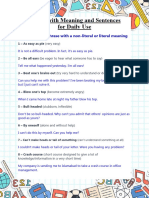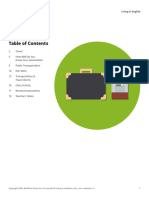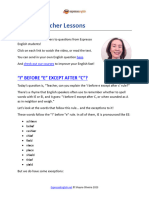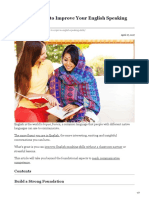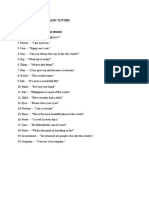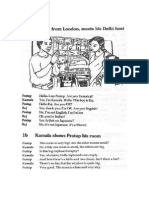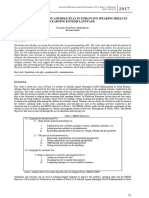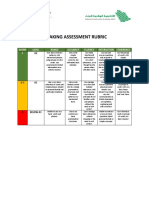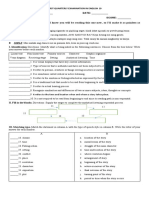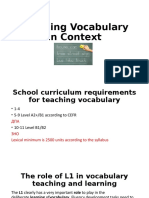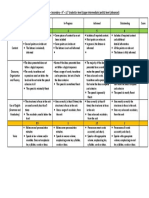Introduction
Welcome to 400 Must-Know Questions and Answers for Daily English Conversations —
your ultimate guide to mastering English through practical, real-life conversations!
Learning English doesn’t have to be complicated or overwhelming. By focusing on
questions and answers that people use every day, this eBook helps you build confidence,
improve your fluency, and expand your vocabulary naturally.
Inside, you’ll find hundreds of commonly used questions about everyday topics like
shopping, travel, work, and more. Each question comes with a sample answer, key
phrases, and detailed explanations to help you understand how to use the language
effectively in real situations.
Whether you’re a beginner trying to speak your first sentences or an intermediate
learner looking to sharpen your conversational skills, this eBook is designed to make
your journey simple, fun, and effective.
Let’s get started on unlocking your potential to speak English confidently and naturally!
For more excellent English learning resources, please subscribe to our YouTube channel:
https://www.youtube.com/@DailyNativeEnglish
1
� How to Use This eBook
This eBook is structured to help you learn step by step and apply what you learn in real
conversations. Here’s how to make the most of it:
1. Explore the Questions by Topics
The book is divided into everyday topics like food, travel, work, and more. Start with a
topic that interests you or is relevant to your daily life.
2. Learn Through Sample Answers
Each question is paired with a natural, easy-to-understand sample answer. Use these
answers as models to craft your own responses.
3. Focus on Key Phrases
Highlighted key phrases in each question and answer are the building blocks of fluent
English. Study them carefully and practice using them in your own sentences.
4. Understand the Explanations
Detailed explanations are provided for difficult phrases, grammar points, or cultural
nuances. This helps you understand not just what to say, but also why it’s said that way.
5. Practice, Practice, Practice
Use this book as a practice tool! Try answering the questions out loud or writing your
own responses. Repetition is the key to fluency.
6. Apply It in Real Life
After practicing, challenge yourself to use these questions and phrases in real
conversations with friends, colleagues, or language partners.
By following these steps, you’ll develop the confidence and skills to navigate English
conversations with ease. Remember, learning a language is a journey—be patient with
yourself and enjoy the process!
2
� Topics
1. Weather ............................................................................................................................6
2. Shopping .........................................................................................................................11
3. Family Life ..................................................................................................................... 16
4. Health and Fitness ......................................................................................................... 21
5. Education ....................................................................................................................... 26
6. Technology ..................................................................................................................... 31
7. Hobbies .......................................................................................................................... 36
8. Holidays and Celebrations.............................................................................................. 41
9. Relationships .................................................................................................................46
10. Nature and Environment .............................................................................................. 51
10. Transportation ............................................................................................................. 57
11. Festivals and Traditions ................................................................................................ 62
12. Sports and Games ......................................................................................................... 67
13. House and Home ........................................................................................................... 72
14. Art and Creativity ......................................................................................................... 77
15. Fashion and Style..........................................................................................................82
16. Finance and Budgeting ................................................................................................. 87
17. News and Current Events .............................................................................................. 92
18. Movies and Entertainment ........................................................................................... 97
19. Music and Instruments ............................................................................................... 102
20. Social Media ............................................................................................................... 107
21. Future and Goals ......................................................................................................... 112
3
�22. Friendship ................................................................................................................... 117
23. Pets and Animals ........................................................................................................ 122
24. Travel Experiences ..................................................................................................... 126
25. Food and Cooking ....................................................................................................... 130
26. Memories and Experiences ......................................................................................... 134
27. Personal Development ................................................................................................ 138
28. Culture and Diversity ................................................................................................. 142
29. Work and Career ........................................................................................................ 146
30. Social Issues ............................................................................................................... 150
31. Technology and Innovation ......................................................................................... 154
32. School Life .................................................................................................................. 158
33. Idols and Pop Culture ................................................................................................. 164
34. Nature and Environment ............................................................................................ 170
35. Clothes and Accessories .............................................................................................. 176
36. Technology and Social Change .................................................................................... 182
37. Local Communities ..................................................................................................... 188
38. Daily Routine ............................................................................................................. 194
39. Motivation and Discipline .......................................................................................... 199
40. Self-Care .................................................................................................................... 205
4
� Copyright © 2024 Daily Native English. All rights reserved.
No part of this publication may be reproduced, distributed, or transmitted in any form
or by any means, including photocopying, recording, or other electronic or mechanical
methods, without the prior written permission of the publisher, except in the case of
brief quotations used in reviews or critical analyses.
This eBook is for personal use only. It may not be resold or distributed. Violators will be
prosecuted to the fullest extent of the law.
Disclaimer Notice:
This eBook is intended to provide general guidance and educational tips for improving
English language skills. The content in this book is based on personal experiences,
research, and teaching practices. While every effort has been made to ensure the
accuracy and reliability of the information provided, the author make no representations
or warranties of any kind, express or implied, regarding the completeness, accuracy, or
suitability of the material.
This book is not a substitute for professional language instruction or certification
courses. Readers are encouraged to use this material as a supplemental resource and
consult qualified educators or institutions for formal training if needed.
The author shall not be held liable for any errors, omissions, or actions taken based on
the information contained in this eBook. The responsibility for applying the concepts
and techniques presented lies solely with the reader.
5
� 1. Weather
1. What’s the weather like today?
Sample Answer:
"Today, the weather is mild, with some scattered clouds. It's not too hot or cold, and
there's a light breeze, so it's quite pleasant outside."
Key Phrases:
• Mild: Used to describe weather that is not extreme—neither too hot nor too cold.
• Scattered clouds: Refers to a few clouds in the sky, but not enough to cover it
entirely.
• Pleasant: Describes something that feels comfortable and enjoyable.
Note: When describing the weather, use adjectives that show the level of intensity (mild,
warm, freezing). This helps paint a clear picture for the listener.
2. Do you prefer sunny or rainy days?
Sample Answer:
"I prefer sunny days because I find that they help me feel more energized and
productive. Bright weather always puts me in a good mood and motivates me to get
things done."
Key Phrases:
• Energized: Feeling full of energy or motivation, often due to bright weather.
• Bright weather: Refers to sunny and clear weather.
• Get things done: A common phrase meaning to complete tasks or be productive.
Note: When explaining preferences, try to use reasons that reflect your personal
experience. This makes your answer more relatable and authentic.
6
�3. How do you prepare for cold/hot weather?
Sample Answer:
"For cold weather, I usually bundle up in warm layers and wear a thick coat to stay
warm. In hot weather, I make sure to apply sunscreen and wear lightweight clothes to
keep myself cool."
Key Phrases:
• Bundle up: A casual phrase meaning to dress warmly, especially in layers.
• Apply sunscreen: Refers to using lotion or cream to protect your skin from the
sun.
• Cool: Describes the condition of being comfortable and not too hot.
Note: It’s important to mention specific actions like dressing appropriately or using
protective items to show you understand how to deal with the weather.
4. What’s your favorite season, and why?
Sample Answer:
"My favorite season is autumn because the air is crisp, and the leaves turn beautiful
shades of orange and red. It’s a time when the weather is refreshing, and I can enjoy
long walks without feeling too hot or cold."
Key Phrases:
• Crisp: Describes the refreshing, cool feeling in the air, often in autumn or spring.
• Refreshing: Used to describe weather that is comfortable and rejuvenating.
Note: When discussing your favorite season, try to highlight what makes it unique in
terms of weather and personal activities you enjoy.
5. Have you ever experienced extreme weather like a
hurricane or blizzard?
7
�Sample Answer:
"Yes, I’ve experienced a blizzard once. The snow was coming down hard, and the wind
was so strong that visibility was almost zero. It was intense, and we had to stay
indoors for safety."
Key Phrases:
• Coming down hard: Refers to heavy snow or rain falling quickly.
• Intense: Used to describe extreme conditions, whether it's weather or an
experience.
• Stay indoors: A common phrase meaning to remain inside for safety or comfort.
Note: For questions about extreme weather, try to share a specific experience if you have one. It
makes your answer more engaging and allows you to use descriptive vocabulary.
6. Do you believe in climate change? How has the
weather in your area changed?
Sample Answer:
"I absolutely believe in climate change. Over the past few years, the weather in my area
has become more unpredictable. We’re seeing more extreme temperatures, with
summers getting hotter and winters becoming milder. It's definitely concerning, and it
seems like the seasons are blurring together."
Key Phrases:
• Unpredictable: Describes weather that is difficult to forecast or that changes
suddenly.
• Extreme temperatures: Refers to very hot or very cold weather, often beyond
what is typical for the area.
• Blurring together: Used to describe the merging or loss of distinction between
seasons due to unusual weather patterns.
Note: Discussing climate change often requires using phrases that show the shift in
patterns, like "extreme temperatures" or "unpredictable." These help emphasize the idea
of change.
8
�7. How does the weather affect your mood?
Sample Answer:
"Weather has a big impact on my mood. On sunny days, I feel more motivated and
energetic. But on rainy days, I tend to feel a bit down and less productive. It’s like the
weather affects my energy levels, especially when it’s gloomy outside."
Key Phrases:
• More motivated: Feeling inspired or eager to work or do something.
• Down: Refers to feeling sad or low in spirits, often caused by dreary weather.
• Gloomy: Describes weather that is dark, overcast, and unappealing, often
affecting mood negatively.
Note: Many people associate their mood with the weather. Describing how it impacts
you personally can help you connect with others on the topic.
8. What’s the best thing to do on a rainy day?
Sample Answer:
"The best thing to do on a rainy day is to curl up with a good book and a cup of tea. I
also love watching movies or spending time cooking something warm. It’s all about
enjoying the cozy atmosphere."
Key Phrases:
• Curl up: To sit or lie comfortably in a relaxed position, often with blankets or a
good book.
• Cozy atmosphere: Refers to a warm, comfortable environment, usually indoors,
that feels relaxing.
Note: Rainy days are often associated with indoor activities. When answering, think of
activities that make the day feel comforting or peaceful.
9
�9. What’s the hottest or coldest day you remember?
Sample Answer:
"I remember the hottest day last summer when it reached over 40°C. It was so
sweltering that I couldn’t even stay outside for long. On the coldest day, it dropped
below -10°C, and the wind chill made it feel even colder."
Key Phrases:
• Sweltering: Describes very hot, uncomfortable weather.
• Below: Used to refer to temperatures lower than a certain point.
• Wind chill: Refers to how cold it feels when the wind makes the temperature
seem colder than it is.
Note: When describing extreme temperatures, use strong adjectives like "sweltering" or
"freezing" for emphasis. It helps convey the intensity of the experience.
10. How does the weather influence your plans for the day?
Sample Answer:
"The weather can definitely influence my plans. If it’s sunny, I’m more likely to go for a
walk or spend the day outdoors. But if it’s rainy or cold, I prefer to stay in and work on
indoor activities like reading or cooking."
Key Phrases:
• Go for a walk: A common phrase for taking a walk outside, usually for exercise
or relaxation.
• Stay in: Means to remain indoors instead of going out, often to relax or avoid bad
weather.
Note: The weather often affects plans, and it's useful to mention how you adapt your
activities based on the forecast. This shows practical language use in everyday
situations.
10
� 2. Shopping
1. Where do you usually go shopping?
Sample Answer:
"I usually go shopping at the mall because it offers a wide variety of stores in one place.
Sometimes, I visit local boutiques when I'm looking for something more unique or one-
of-a-kind."
Key Phrases:
• Wide variety: Refers to a large selection of different things, like stores or items.
• Unique: Describes something special or different from the usual.
• One-of-a-kind: Refers to something that is unique or unlike anything else.
Note: When answering about where you shop, mentioning specific places helps to add
personality to your response.
Enjoying this sample?
Buy now to continue reading the full eBook
11


